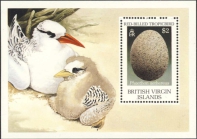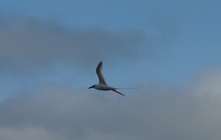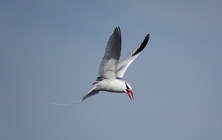WoRMS taxon details
Phaethon aethereus Linnaeus, 1758
137177 (urn:lsid:marinespecies.org:taxname:137177)
accepted
Species
marine, terrestrial
Linnaeus, C. (1758). Systema Naturae per regna tria naturae, secundum classes, ordines, genera, species, cum characteribus, differentiis, synonymis, locis. [The system of nature through the three kingdoms of nature, according to classes, orders, genera, species, with characters, differences, synonyms, places.]. <em>Impensis Direct. Laurentii Salvii. Holmiae [Stockholm].</em> 1(10) [iii], 824 p., available online at https://biodiversitylibrary.org/page/726886 [details] Available for editors  [request]
[request]
Description Length: (excluding streamers) 50-55 cm. Colour: adult: white with uneven black barring on back, rump and inner wing...
Distribution summer visitor of the Gulf of Maine; usually found Tropical Oceans
Description Length: (excluding streamers) 50-55 cm. Colour: adult: white with uneven black barring on back, rump and inner wing coverts, black crescent through the eye and on crown; flight feathers with outer web of primaries black, inner white, secondaries black with white tips and tertials black; tail and tail streamers white; bill red, legs and feet yellow, webs black; immature like adult but without streamers and bill pale green. Habitat: open ocean breeds on oceanic islands. [details]
Distribution summer visitor of the Gulf of Maine; usually found Tropical Oceans
Distribution summer visitor of the Gulf of Maine; usually found Tropical Oceans [details]
WoRMS (2025). Phaethon aethereus Linnaeus, 1758. Accessed at: https://www.marinespecies.org/aphia.php?p=taxdetails&id=137177 on 2025-05-04
Date
action
by
![]() The webpage text is licensed under a Creative Commons
Attribution 4.0 License
The webpage text is licensed under a Creative Commons
Attribution 4.0 License
Nomenclature
original description
Linnaeus, C. (1758). Systema Naturae per regna tria naturae, secundum classes, ordines, genera, species, cum characteribus, differentiis, synonymis, locis. [The system of nature through the three kingdoms of nature, according to classes, orders, genera, species, with characters, differences, synonyms, places.]. <em>Impensis Direct. Laurentii Salvii. Holmiae [Stockholm].</em> 1(10) [iii], 824 p., available online at https://biodiversitylibrary.org/page/726886 [details] Available for editors  [request]
[request]
basis of record van der Land, J. (2001). Tetrapoda, <B><I>in</I></B>: Costello, M.J. <i>et al.</i> (Ed.) (2001). <i>European register of marine species: a check-list of the marine species in Europe and a bibliography of guides to their identification. Collection Patrimoines Naturels,</i> 50: pp. 375-376 (look up in IMIS) [details]
basis of record van der Land, J. (2001). Tetrapoda, <B><I>in</I></B>: Costello, M.J. <i>et al.</i> (Ed.) (2001). <i>European register of marine species: a check-list of the marine species in Europe and a bibliography of guides to their identification. Collection Patrimoines Naturels,</i> 50: pp. 375-376 (look up in IMIS) [details]
Other
context source (Bermuda)
Dobson, A. F. (2002). A Birdwatching Guide to Bermuda. Arlequin Press, Chelmsford, Essex, 173 pp. [details]
context source (PeRMS) Imarpe. (2022). Informe ejecutivo del crucero 2202-04 de Evaluación Hidroacústica de Anchoveta y Otros Recursos Pelágicos, realizado entre el 15 de febrero al 09 de abril del 2022. <em>Imarpe.</em> 57p., available online at https://cdn.www.gob.pe/uploads/document/file/3084651/INFORME%20EJECUTIVO%202202-04.pdf?v=1652289648 [details] Available for editors [request]
[request]
additional source Peterson, R.T.; Peterson, V.M. (2002). A field guide to the birds of eastern and central North America. <em>Fifth Edition.</em> Peterson Field Guide Series. Houghton Mifflin Company. New York. 427 p. [details]
additional source Vanner, M. (2003). The encyclopedia of North American birds. <em>Paragon Publishing.</em> 1-383. [details]
additional source Brown, L.H., E.K. Urban & K. Newman. (1982). The Birds of Africa, Volume I. <em>Academic Press, London.</em> [details]
additional source Gallardo, J. C.; Macías, V.; Velarde, E. (2009). Birds (Vertebrata: Aves) of the Gulf of Mexico. <em>In: Felder, D.L. and D.K. Camp (eds.), Gulf of Mexico–Origins, Waters, and Biota. Biodiversity. Texas A&M Press, College Station, Texas.</em> Pp. 1321–1342. [details]
additional source Liu, J.Y. [Ruiyu] (ed.). (2008). Checklist of marine biota of China seas. <em>China Science Press.</em> 1267 pp. (look up in IMIS) [details] Available for editors [request]
[request]
context source (PeRMS) Imarpe. (2022). Informe ejecutivo del crucero 2202-04 de Evaluación Hidroacústica de Anchoveta y Otros Recursos Pelágicos, realizado entre el 15 de febrero al 09 de abril del 2022. <em>Imarpe.</em> 57p., available online at https://cdn.www.gob.pe/uploads/document/file/3084651/INFORME%20EJECUTIVO%202202-04.pdf?v=1652289648 [details] Available for editors
additional source Peterson, R.T.; Peterson, V.M. (2002). A field guide to the birds of eastern and central North America. <em>Fifth Edition.</em> Peterson Field Guide Series. Houghton Mifflin Company. New York. 427 p. [details]
additional source Vanner, M. (2003). The encyclopedia of North American birds. <em>Paragon Publishing.</em> 1-383. [details]
additional source Brown, L.H., E.K. Urban & K. Newman. (1982). The Birds of Africa, Volume I. <em>Academic Press, London.</em> [details]
additional source Gallardo, J. C.; Macías, V.; Velarde, E. (2009). Birds (Vertebrata: Aves) of the Gulf of Mexico. <em>In: Felder, D.L. and D.K. Camp (eds.), Gulf of Mexico–Origins, Waters, and Biota. Biodiversity. Texas A&M Press, College Station, Texas.</em> Pp. 1321–1342. [details]
additional source Liu, J.Y. [Ruiyu] (ed.). (2008). Checklist of marine biota of China seas. <em>China Science Press.</em> 1267 pp. (look up in IMIS) [details] Available for editors
 Present
Present  Present in aphia/obis/gbif/idigbio
Present in aphia/obis/gbif/idigbio  Inaccurate
Inaccurate  Introduced: alien
Introduced: alien  Containing type locality
Containing type locality
Unreviewed
Description Length: (excluding streamers) 50-55 cm. Colour: adult: white with uneven black barring on back, rump and inner wing coverts, black crescent through the eye and on crown; flight feathers with outer web of primaries black, inner white, secondaries black with white tips and tertials black; tail and tail streamers white; bill red, legs and feet yellow, webs black; immature like adult but without streamers and bill pale green. Habitat: open ocean breeds on oceanic islands. [details]Distribution summer visitor of the Gulf of Maine; usually found Tropical Oceans [details]
| Language | Name | |
|---|---|---|
| Dutch | roodsnavelkeerkringvogel | [details] |
| English | red-billed tropicbird | [details] |
| French | phaéton à bec rouge | [details] |
| German | Rotschnabel-Tropikvogel | [details] |
| Hebrew | פתון אדום-מקור | [details] |
| Lithuanian | raudonsnapis faetonas | [details] |
| Polish | faeton białosterny | [details] |
| Russian | красноклювый фаэтон | [details] |
| Spanish | rabijunco etéreo | [details] |
| Turkish | kırmızı gagalı tropik kuşu | [details] |
| Ukrainian | Фаетон | [details] |







